 |
||
|
||
| ||
By Alexander Kondakov (kondalex@ixbt.com)
 IntroductionThe event that took place on February 17 to 18 in Moscow did without much noise or numerous pressmen, though it wasn't less interesting or important than a presentation of any device. Under the slogan of "The way it's meant to be played" NVIDIA held the seminar for developers. The slogan means that once a user starts a game he sees exactly what the developers want him to. For two days the experts at NVIDIA spoke and showed to our developers how it is better to program modern effects for modern accelerators. But let's start from the very beginning. February 17The day was kicked off with the introductory word of Alain Tiquet, European Marketing Director, NVIDIA, who talked about the company's current achievements, its market share and nearest prospects. He highlighted four key directions in the company's general policy. I'd like to attract your attention to one of them. I think that the key aspect is usage of UDA - unified drivers architecture. Alain says that any user can download a new driver version which will suit his or her video card, be it TNT, GeForce256 or GeForce FX. He also says that a user will get a performance gain with the new driver on any card, but I wouldn't agree with him. I test new driver versions and can see the real situation. :-) Nevertheless, the driver unification is more loyal both to users and developers. There is probably one unpleasant aspect: when the number of chips exceeds, for example, a thousand (today the drivers support about 124 (!) different chips), the driver will be too big, and it will be rather difficult for the developers to make optimizations for all current chips. But even now I doubt and I have reasons for it, that these optimizations are are full. They are made only for the most popular latest chipsets. Then he passed the word to the technical experts. I must say that the conference hall was overcrowded with our developers of games and utilities. The organizers were going to provide every expert with a separate computer,
but as there were really a lot of people, some computers had to be shared
by two or even three persons. All 20 computers were equipped with the NVIDIA's
latest solution GeForce FX 5800 Ultra.
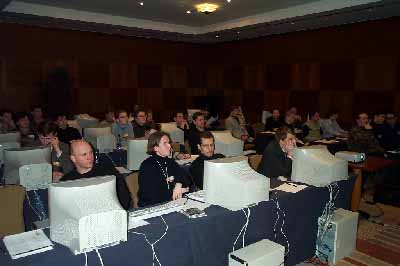 After a brief introduction John Spitzer started describing the new solutions.
He spoke about the GeForce FX architecture and demonstrated very curious
demo programs specially written for demonstration of capabilities of the
new chip.
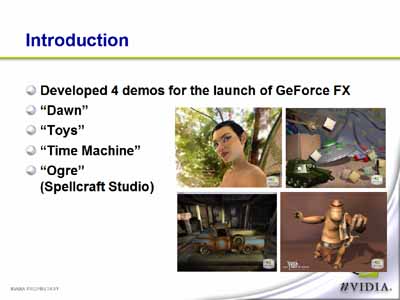 After that Chris Wynn told us interesting things about the higher-level
languages specially created for programming video accelerators such as
Cg (C for graphics) from NVIDIA and HLSL (High level shader language) from
Microsoft. Surely, he drew attention mostly to the Cg.
 When the floor was given to Sebastien Domine, he spoke about the shader
technologies in detail. No wonder that these technologies are paid so much
attention to, as they are going to become the main tool in game development.
It is shaders that can help make unprecedented real-time effects working
at a good speed. :-)
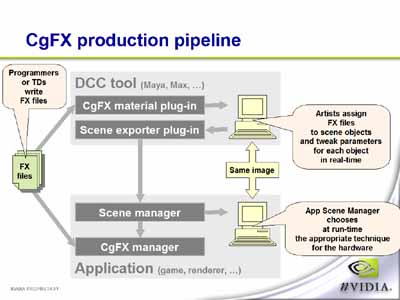 The Sebastien demonstrated a working plug-in for 3ds max 5.1. The idea
is that this plug-in runs when a texture is put on the surface, and you
can choose a type of this texture, its possible lighting variants, shading
etc. using the shaders. All it works in real-time and the result appears
in the viewport window, you don't need to do off-line rendering which can
take a lot of time.
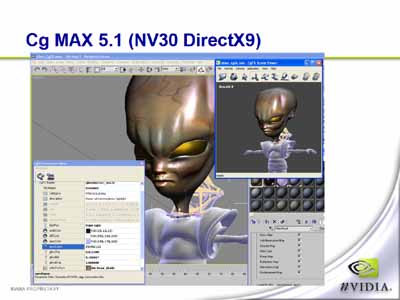 If you don't like something you can edit the shader's source code right
in the 3ds max, which certainly adds flexibility when using this technology.
Shaders are added as .fx files. Sebastien promised that this plug-in and
.fx files will soon become available for free at the NVIDIA's site. Let's
wait and try it as I think this technology is unique and very convenient
for modelers. Similar plug-ins will soon appear for the MAYA and SoftImage,
and in certain time this mechanism will be integrated in engines of these
software products.
 The Sebastien touched upon the DirectX 9 and its new capabilities, in particular,
concerning GeForce FX. He unveiled information about new specific caps
and what can be achieved with them.
 After that Chris Wynn gave particular examples showing effectiveness of the Cg. After those quite simple examples he suggested that we make a kind of a laboratory work to make sure that such programming is very effective. Several passes on the keyboard, and here is the result in almost no time. The visitors tried this new really handy programming tool with much interest. At the end of the day it was the turn of the program part called Show 'n' Tell where the developers showed what they reached in the sphere of creation of new 3D engines, various utilities etc. Exactly after this part the participants took a liking to each other because they understood that they were actually colleagues rather than competitors. Some demonstrations amazed even NVIDIA. Unfortuantely, I can't dwell on what was shown exactly, but believe me, it was rally interesting to peep into the future. February 18Unfortunately, I failed to be present at the Intel's demonstration in the morning the next day, that is why I can't share my impressions. Judging by the thoughtful faces of people leaving the hall after the 4-hour Intel's lecture, they liked it. According to the schedule, Alex Klimovitski was to speak about the Intel Vtune Analyzer. Quadro FXAt that time I was in another conference hall watching and listening to
the presentation of NVIDIA's professional accelerators, and I'm going to
tell about it in more detail.
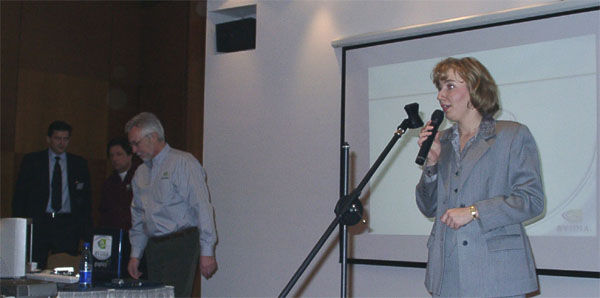 Traditionally, Alain was first to speak and he focused on the company's plans on the professional market. Then he gave floor to Walter Mund-Blum, European Sales Director dealing with professional cards. Walter told us a short but exhaustive story of development of NVIDIA's professional cards, gave some particulars of the company's strategy on this market and showed latest cards Quadro FX 2000 and Quadro FX 1000. As we can tell from the name, these cards are based on the NV30GL. The NV30 and the NV30GL don't differ much; moreover, first of all the company developed a professional version and then adapted it for use in game accelerators. The following figures prove it. They produced about 100,000 nv30 & nv30gl chips, and the half will be used in professional solutions. Also, Walter mentioned that production of game cards is usually delegated to third parties such as ASUS, Abit, MSI, Leadtek etc., but professional products are made by the company itself. The partners get almost a finished product. As we also found out, the company collaborates with developers of professional software, and new software versions supporting the latest 3D graphics solutions should be expected very soon. At this stage the company makes plug-ins for popular animation and model creation programs such as 3DS MAX, MAYA, Softimage|XSI and others. Then it was the turn of the largest distributor of NVIDIA's professional cards - PNY. Thierry Brenier told us about the PNY's sphere of activity and confided the origin of the company's name. It turned out that the founder first lived in France, Paris, and started his work right there. Then, as the company was growing, he moved to New-York. And the name actually stands for Paris-New-York. PNY has four offices in Europe (Germany, Great Britain, France and Italy) and premises in Europe and Taiwan. He said that they focus on production of various memory types. Memory chips are actually bought from such grands as Samsung, Micron, Hynix and others. He also mentioned that the memory market, and in particular, the rapidly growing market of flash devices is of much interest for them. And, as I mentioned above, PNY is the largest distributor of NVIDIA's professional solutions. Mr. Brenier was followed by Artem Avedian, representative of SolidWorks Russia which keeps the leading position in developing CAD-oriented applications. Artem said that a new version of SolidWorks 2004 was going to appear this summer, and it will support shaders usage. Such solution will help engineers using this software product to better evaluate their products yet at the developing stage. Also, it will help to unload the CPU for other needs and use the GPU more rationally. That was all about the presentation of the Quadro FX line, and I returned to the hall where the conference for developers was held. When I entered Chris was speaking about new OpenGL extensions for programming
of latest accelerators. In my opinion, the lecture was too informative,
and taking into account the dim light in the room, the participants starting
yawning. :-)
 Nevertheless, I really liked the lecture. Well, NVIDIA considers that this
standard has the priority and, in the first place, the company provides
support exactly for this standard. DirectX is not so attractive for NVIDIA
to some reason. I think that it's so because OpenGL is an open standard.
Anyone can make an extension and offer to the consortium for consideration.
Do you remember how many extensions there are in the NVIDIA OpenGL? The
company having professional engineers and programmers can develop very
useful extensions for the standard and can dictate its rules. The OpenGL
Consortium unites a lot of companies, and all of them adequately approach
this issue.
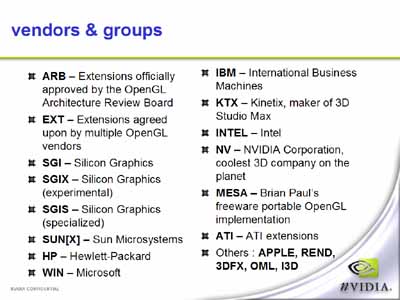 I can't say the same about monopolist Microsoft and its DirectX. However, the OpenGL is more complicated than the DirectX. This is one of the reasons why the OpenGL doesn't enjoy much popularity, but the most advanced game creation studios (I hint at ID Software) use exactly this API. Then John turned to the weak points of programming of modern accelerators
and how one can avoid them.
 As we were short of time, John covered it very quickly and without many
details, though I think this aspect should be give more time because it
will affect speed of future games.
 Then Sebastien showed us the Melody utility which makes it easy to create LODs. Unfortunately, the Intel's representative and Chris took more time than it was scheduled, and a part of the remaining program was cut down. Thus, the second laboratory work was unfortunately omitted. And that time was devoted to further demonstration of the domestic achievements and to questions and answers. Apart from technical questions some inquired about the next generation GPU and asked other tricky questions. For example, Alain mentioned that the GeForce FX 5800 Ultra consumes about 60W and it needs a good power supply unit starting from 350W for its OK operation, as well as additional power supply for the card itself. I asked what could happen if I provided the additional power. He responded that nothing bad would happen, only the card would work much slower. But what if instead of 12V of this additional power I would supply 24V? The card won't work faster - said Alain, - but it can start smoking. :-) When the interrogating was over, every developing company was given one GeForce FX 5800 Ultra card. The people who received such a gift became very animated and discussed it very noisily. I'm sure such step will help the Russian developers to optimize their latest games with respect to the peculiarities of the GeForce FX architecture and create new beautiful effects. In its turn, it will stir up the interest of buyers as everyone wants more nice and interesting games. At the same time, at the seminar we discussed various problems, and it must help the developers find the way to avoid them in games providing better playability (some versions, not very well optimized, which were demonstrated at Show 'n' Tell had only 3-4 fps in 1024x768x32Bit on the GeForce FX; it's not enough for a game, but remember that all demonstrated samples were the games of the future). Also, at the end of the second day the winners of the Cg Contest held at http://www.ixbt.com/ were awarded with the prizes: the winner at the first place was given an Intel Pentium 4 3GHz based computer equipped with the GeForce FX 5800 Ultra video card, for the second place they prepared the motherboard with the GeForce FX 5800 Ultra video card and the third position went along with the GeForce FX 5800 Ultra. iXBT.com, NVIDIA and I congratulate the winners once again and wish them further success. Well, I hope this event is not the last of its kind, and they will again take place benefiting all sides. The hardware maker gets a powerful feedback from the software developers, while the latter get more skills. I would like to thank the guys from NVIDIA for their patience when listening to us speaking English :), as well as for excellent work in making new products and for carefully prepared seminar. Also, I'd like to thank IT-labs for the excellent maintenance of this
event. I hope such events will take place again.
 I'm also very grateful to Chris Wynn for the presentation materials
and some photos from this event.
Write a comment below. No registration needed!
|
Platform · Video · Multimedia · Mobile · Other || About us & Privacy policy · Twitter · Facebook Copyright © Byrds Research & Publishing, Ltd., 1997–2011. All rights reserved. |